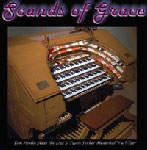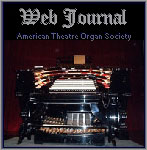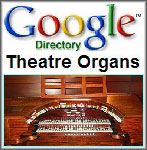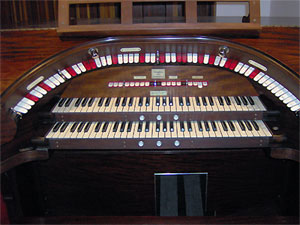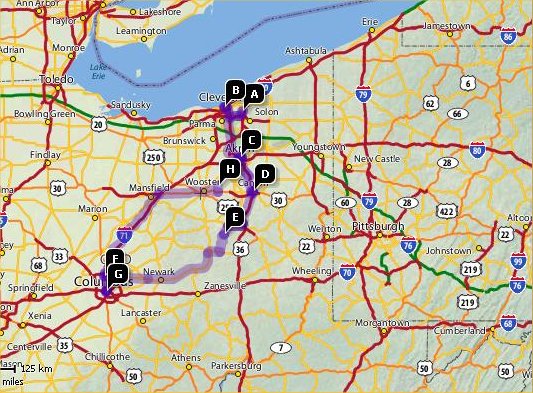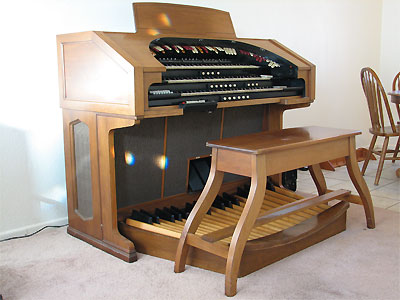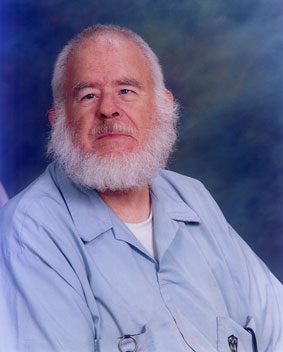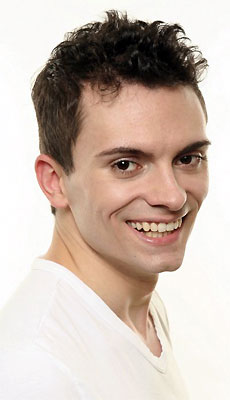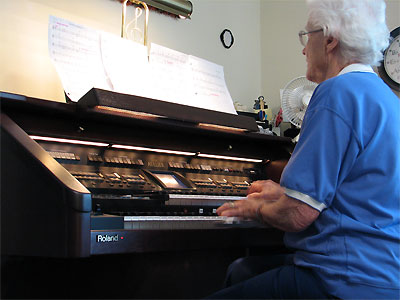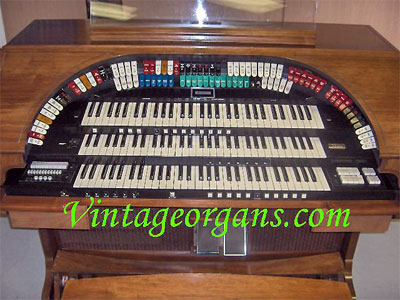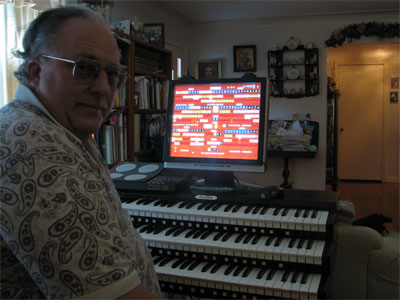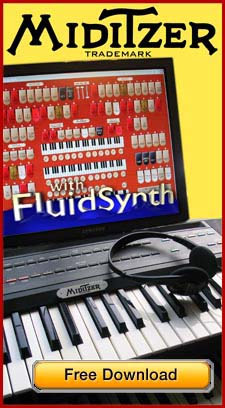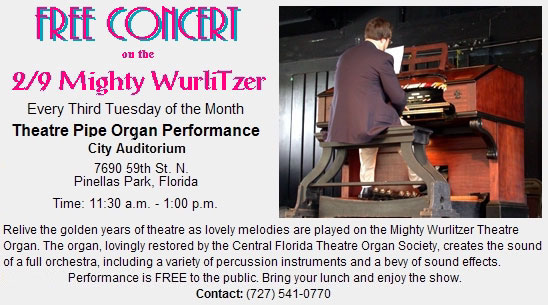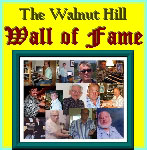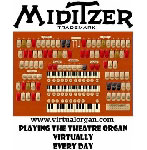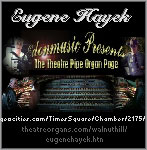
|
|
|
|
Volume Four - Issue Seven
The Control Room - Richard Mogridge - Webmaster
Walnut Hill Productions |
|
FROM THE WEBMASTER'S DESK |
||||||||||||||||||||||||||||||||||||||||||||||||||||||||||
ORGAN OF THE MONTH
|
||||||||||||||||||||||||||||||||||||||||||||||||||||||||||
|
We begin the month of July with a busy time of catching up the website and planning for the upcoming Ohio Organ Crawl in the latter half of August, 2007. It has come to our attention that the city of Ridgecrest is to build a full scale performing arts center, which we strongly feel needs a Theatre Pipe Organ as part of the program manifest. Some of the folks involved in this massive project will include the Mayor of Ridgecrest along with several other city officials who are planning the building, as well as the local Inland Adventurer Newspaper which will be carrying the story as it unfolds.
Playing The TPO From Coast To Coast
|
||||||||||||||||||||||||||||||||||||||||||||||||||||||||||
|
Pointer A. B. C. D. E. F. G. H. |
Location Beachwood Cleveland Akron Canton Baltic Worthington Columbus Orrville |
Installation Doug Powers Residence Gray's Armory Civic Theater Palace Theater Dorothy Steiner Residence Worthington High School David Geiger Residence Schantz Organ Company |
Contact Doug Powers Harold Wade Dorothy Steiner Robert Beck David Geiger |
Date & Time 8/20/07 3:30PM 8//07 8//07 8/17/07 All Day 8/26/07 2~5PM 8//07 8//07 8//07 |
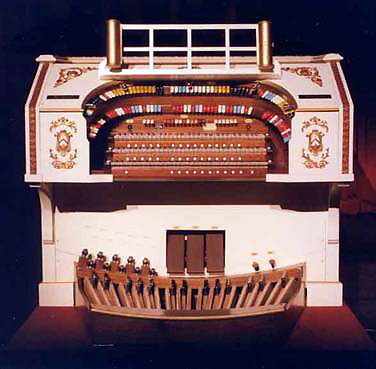
The console of the 3/11 Mighty Kilgen
at the Palace Theatre in Canton, Ohio.
This historic event for Walnut Hill Productions is being made possible by a generous contribution from Dan Rowland and the full cooperation of the Western Reserve Theatre Organ Society and the Central Ohio Theatre Organ Society, proud chapters of the American Theatre Organ Society.
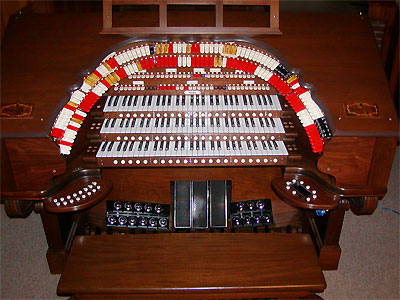
The stop sweep of the Mighty Walker Custom Digital Theatre Organ
installed at the Doug Powers residence in Beachwood, Ohio.
While in Ohio, the Bone Doctor is scheduled to play the 3/11 Mighty Kilgen at the Palace Theatre in Canton, a lovely 3/17 Mighty WurliTzer at the residence of Dorothy Steiner in Baltic, possibly the Civic Theatre 3/19 Mighty WurliTzer, the Mighty Walker Custom Digital Theatre Organ at the residence of Doug Powers in Beachwood, the Worthington High School 3/12 Mighty WurliTzer and Dave Geiger's 2/9 Mighty WurliTzer (these two instruments located in Columbus,) and the Gray's Armory 3/15 Mighty WurliTzer in Cleveland (see table above at the beginning of this article.)
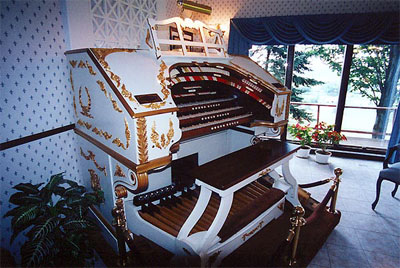
The console of the 3/17 Mighty WurliTzer at
the residence of Dorothy Steiner in Baltic, Ohio.
Also scheduled is a tour of the Schantz Pipe Organ Company's factory and showroom. Doc intends to play any organ they will give time on the bench of while there. Finally, he gets to play Dan Rowland's wonderful vintage Rodgers 321 analogue electronic theatre organ and perhaps his freshly rebuilt Style 260 Mighty MidiTzer. Woot!
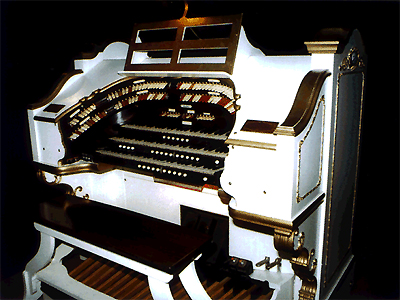
The console of the 3/15 Mighty WurliTzer at
Gray's Armory in Cleveland, Ohio.
The Bone Doctor Gets A Conn 650
Analogue Electronic Theatre Organ
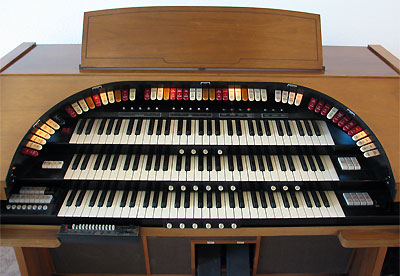
The stop sweep of the Mighty Conn 650 theatre organ.
On July 19th, Cyrus Roton and the Bone Doctor went to San Bernardino to see fellow Walnut Hill Wall Of Fame member and great friend Paul Kealy to deliver a Hammond Concorde with a Leslie 725 speaker cabinet to his church, this great instrument being an unsolicited gift from Cyrus.
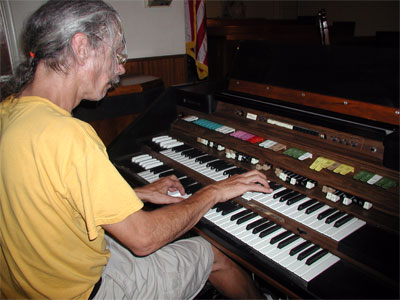
The Bone Doctor at the console
of the Hammond Concorde electronic organ.
The Hammond Concorde has the prerequisite drawbars plus it is endowed with several theatre organ stops. Paul was thrilled that the Hammond Company had made such an instrument and he was not expecting to have one in his church. The gift was a major surprise for Paul, one he was very pleased with.
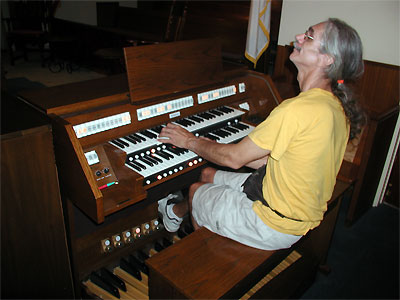
The Bone Doctor at the console of Paul Kealy's Baldwin Classical Organ
As a token of his appreciation and gratitude for the work done by the Walnut Hill Productions team to preserve and promote the King of Instruments, Paul gave Doc a vintage Conn 650 analogue theatre organ. The donation of this vintage machine was something Paul had been planning since Doc left Florida in 2006.
The instrument was in nearly mint shape except for some minor dulling of the walnut finish on the horseshoe lid due to sunlight shining on it through a window in the home of the previous owner well before Paul aquired it.
This magnificent organ is concidered by many in the industry to be the finest instrument Conn ever built, with three 61-note manuals and a 32-note pedalboard. The stops are arranged in true WurliTzer fashion, and there is a combination action with six pistons per manual for the Accompaniment and the Great. There are a number of other pistons for more functions and the expression is split between two swell shoes.
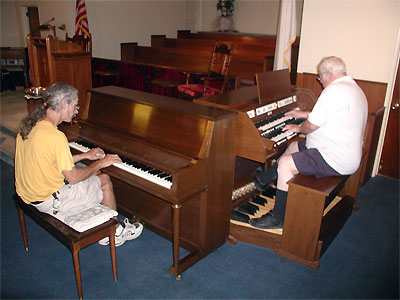
Cyrus Roton and the Bone Doctor jamming at Paul Kealy's church.
While at the church, there was a short jam session with Cyrus at the Baldwin and Doc on the piano. The acoustics of the sanctuary were nothing short of stunning as the sound of the organ and piano rang out to the strains of Back to Sorento. What a wonderful place! After the jam, the men set about loading the Conn 650 for the trip back to Ridgecrest.
Upon inspection before loading, it was learned that the console speakers would need reconnecting because the wires had been routed to external speakers by cutting them to splice on a long cable for the remote cabinets. We also discovered worn pedal felts that would need replacing. According to Paul, everything on the organ works. There was even an owner's manaul containing detailed operation along with complete stop lists and registrations for the various pistons. Also, a spare power amplifer was included.
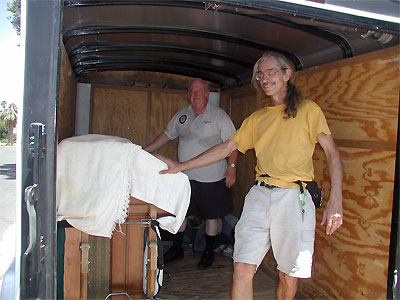
Cyrus Roton and the Bone Doctor load up the Conn 650.
The organ was loaded and the three gentlemen went to lunch at a fine mexican eatery near the church. On the way out of town, the right rear tire on Cyrus' van developed a bad valve stem and blew out, leaving the vehicle stopped in the middle of the freeway. The CHP stopped and helped us change the blown tire so we could continue on home to Ridgecrest with this beautiful gift. A few miles up the road, we found a tire store and replaced the blown tire, returning the spare to its berth below the rear deck.
The instrument was installed in the home of the Bone Doctor's girlfriend, Suzanne Donnally. This apartment has a large enough living room to accomodate the stately beast.
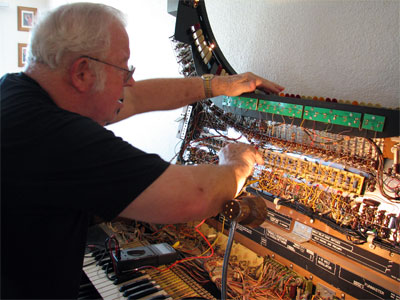
Cyrus Roton working on the Conn 650.
On July 21st, we went over to Miss Donnally's house to work on the Mighty Conn 650 Theatre Organ lovingly named Gertrude. Cyrus quickly repaired the speaker wires and we discovered what to do to the pedals to take out the clacking racket. Also, he discovered four bad switching transistors in the buss bar circuitry and he now has replacements on order, along with some new felts for the pedals.
After the speaker wires were spliced and the horseshoe lid closed for the day, Cyrus took the bench to give the old gal a go. Doc took pictures the whole time. He got shots of Cyrus working on the console and more during his pleasure filled time on the bench. Cyrus was grinning from ear to ear like a young kid as the sound of the Mighty Conn rang out, filling the room with that glorious noise only a TPO can make.
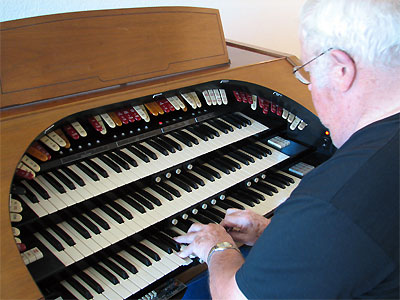
Cyrus Roton at the console of the Conn 650.
After Cyrus played the huge beast, Doc took the bench and went down memory lane, remembering his prior experience with this model from the 70's. What grand tone! There are so many ranks to choose from, and all of them quite real. This machine is going to be a blast to play and record.
The organ has unlimited bass. There are some sweet Tibias and the Vox Humana is to die for. Oh, and the English Post Horn will peel paint! There are four ranks of strings, one being a very lush VDO. There is also the famous Conn Minimatic Drummer attached and it works great, especially on the Latin rhythms.
On July 30th, Cyrus and, Doc went over to perform the needed repairs to the Tibia buss bar circuits and install new up-down stops on the bass pedals. Now all that remains to be done is replace two buss bars in the pedals that control the Accompaniment to Pedal coupler, which is nonfunctional at the moment, but everything else works great.
Now that all the Tibias are playing and the pedals move quietly, the instrument has a tone that simply must be heard to be believed.
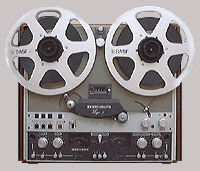
The Bone Doctor At The Mighty Conn 650
Analogue Electronic Theatre Organ
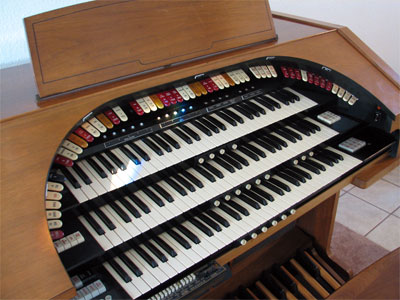
The playing table of the Mighty Conn 650.
On July 25th, Doc took the bench of his newly aquired Mighty Conn 650 analogue electronic theatre organ. He spent the entire day doing a recording session using his trusty Zoom H4 digital audio recorder and played eleven songs listed below for your enjoyment.
- I Couldn't Love You Any More
Playing Time = 2:43, file size = 2.52MB, bit rate = 136KB/sec. - Hop Scotch
Playing Time = 3:51, file size = 3.55MB, bit rate = 136KB/sec. - How Tasteless The Hours
Playing Time = 2:05, file size = 1.95MB, bit rate = 136KB/sec. - Never Grow Old
Playing Time = 3:15, file size = 3.01MB, bit rate = 136KB/sec. - Amazing Grace
Playing Time = 3:45, file size = 3.47MB, bit rate = 136KB/sec. - Just A Closer Walk With Thee
Playing Time = 3:41, file size = 3.41MB, bit rate = 136KB/sec. - Tennessee Waltz
Playing Time = 4:56, file size = 4.57MB, bit rate = 136KB/sec. - My Walking Stick
Playing Time = 4:26, file size = 4.11MB, bit rate = 136KB/sec. - San Antonio Rose
Playing Time = 2:31, file size = 2.35MB, bit rate = 136KB/sec. - Skater's Waltz
Playing Time = 3:16, file size = 3.04MB, bit rate = 136KB/sec. - Yellow Bird
Playing Time = 2:40, file size = 2.48MB, bit rate = 136KB/sec.
When these recordings were made, there remained some restoration work to do on this wonderful organ, including repadding the up and down stops on the pedalboard and replacing six switching transistors in the Tibia buss bar circuitry.
You can hear the missing pads in the pedals on the recordings above, but even with some of the Tibias not working and the blown pads, the instrument still sounds with a golden voice on these tracks. Since doing this session, most of the repairs to this vintage machine have been successfully completed.
We can never thank Paul Kealy enough for this wonderful gift. She will not be just a pretty piece of furniture, because she will get played every day!
Founding Father of Walnut Hill
Recovers After Fall at Home
On the 4th of May, Walnut Hill Founding Father Fred Willis fell at his home while walking into the kitchen and could not get up. There was no way that Doc could get him to his feet, and after seeing te color of his skin, called 911. The city responded with paramedics and an ambulance. They began immediate medical treatment even before leaving for the hospital. Fred was admitted as soon as they arrived at the Center early that evening.
Surgery was performed in the morning of the following day, on a Saturday. Due to irreversable infection and complications caused by advancing diabetes, the toe was amputated. There are other complications the doctors must evaluate, monitor and treat before Fred can come home, but Todd took Fred the "Easy" button Fred keeps near his residence workstation to remind him to pray with us for the miracle of healing and a safe return home.
Fred was excited to hear the news surrounding the Convention and he was glad to see Todd and Doc safely home. We were relived and glad to see Fred alive and reasonably well, on his way to a speedy recovery in the capable hands of the good people at the Ridgecrest Medical Hospital.
Fred was relocated from Ridgecrest Medical Hospital to the Desert Knoll Convalescent Hospital in Victorville, California. The doctors expected him to stay there for at least four and a half weeks.
On Thursday, May 17th of 2007, Cyrus Roton and the Bone Doctor ventured down to Victorville to see Fred at the Desrt Knoll Convalescent Hospital. He was of good cheer but still woozy from the infection. The nurse changed the bandages on his toe while we were there and the would is healing, but it is mending slowly due to his diabetes. Fred's recovery time is now estimated to be around four to six weeks. His brother Paul will be flying down from Washington State in two weeks to held get Fred's house ready for his return sometime between June and July if all goes well.
On May 29th, Fred was relocated from the Desert Knoll facility to the Dersert Valley Memorial Hospital for a second surgery evaluation. Breathing treatments were started to eliminate the fluid collecting on his lungs. The staph infection has proved hard to eradicate, being a very antibiotic resistant strain of bacteria.
On June 1st, Fred returned to the Desert Knoll facility when it was leaned that a second surgery was not needed.
On June 10th, Earnest Todd, Cyrus Roton and the Bone Doctor once again ventured down to Victorville to see Fred. He was looking much better and of good cheer, but there remained a severe rattling cough which had us concerned that something might be amiss.
At 5:30 in the morning of June 14th, Fred was readmitted to the Desert Valley Memorial Hospital because of difficulty breathing. The treatments he was receiving for this were not effective. It was learned that he had a condition known as post-operative phnuemonia. Once he was stabalized on the 16th, Fred was returned to the Desert Knoll facility.
On June the 17th, Fred had a relapse of Phuenomia and was sent back to Desert Valley Memorial for lab work, CAT scans and further testing and treatment. We visited him but could not stay long enough to find out the results, so a visit on the 1st of July was planned. He was once again stablized and returned to Room 57B at Desert Knoll.
On July the 1st, Earnest Todd, Cyrus Roton and the Bone Doctor trekked down to Victorville to see Fred. His skin was looking much better, the toe was healing nicely and his spirits were good. He is still wrestling with a persistant collecting of fluid in his lungs, however.
While we were there, Fred's brother Paul stopped in along with his son, Luke. We brought Fred up to date on the goings on in Ridgecrest and at Walnut Hill. He was very glad to see us and we had a nice long chat about many things. We worked out the logistics of his medical needs and how to carry them out, which set everyone at ease.
On July 8th, we returned to see Fred and found him to be mending but still with a persistant cough due to fluid in his lungs. His skin looked much better and his foot was healing nicely. However, being bedridden for over two months has sapped his strength and thus most of his abulatory abilities are gone.
Fred has lost weight and now tips the scales at 245, down from the 316 he was at before the fall. Because of this, it is now possible to get him transfered back to Ridgecrest where he will have the support and understanding of his circle of local friends who all miss and love him a great deal.
On July 15th, we went to see Fred again and found him to be very much on the mend and making vast improvements, with the rattling cough gone and his skin looking almost normal. We also witnessed him being able to move and lift his legs, something we had not seen in quite a while. We covered the possibility of getting him back to Ridgecrest, but his brother will need to make that happen since we are not Fred's blood kin.
On July 21st, the Walnut Hill Productions team visited Fred to find him healing nicely. The stitches were removed from the amputation and he was able to lift his legs, so much progress is being made toward his recovery. Now all that remains to be done is get him back to Ridgecrest so he can be near his friends during the final phase of getting him well again.
On July 29th, we went to see Fred at Desert Knoll and found him sleeping, that is, until we awakened him to our visit. His surgery was healing nicely to the point of being nearly well, but his spirits were low. He has all but given up. The doctors have told him that the possibility of his return home is unlikely because of extreme and unrecoverable muscle loss as a result of the wide scale staph infection before the surgery. He is nearly invalid and is not expected to recover.
It is still not known how long Fred's recovery will take before he is well enough to return home, if ever. We will let everyone know as soon as we find out. Fred is trying to remain of good cheer throughout all of this ordeal with some persistant but loving coaxing by his friends.
Thank you for keeping him in your prayers. God is listening. We are expecting a miracle.
EDITORIAL ARTICLES
- Richard Mogridge - The Control Room
All about recording the King of Instruments - Tom Hoehn - Console Up!
How to play the Mighty Theatre Pipe Organ - Per Olof Schultz - Skandia WurliTzer
The last WurliTzer Theatre Pipe Organ in Sweden - Russ Ashworth - Mighty MidiTzer
Playing the Theatre Organ virtualy every day! - Jim Reid - Hauptwerk
Martyn Dyde's highly accurate virtual organ from Crumhorn Labs
HEADLINE NEWS
Cameron Carpenter Wows 'Em At Trinity!
This was submitted to the Theatre Organ Home Page Mailing List by fellow list member Robert Lahey on July 6th, 2007. We quote him in blue text below:
Date: Fri, 06 Jul 2007 08:10:17 -0700
From: "Robert Lahey" mortonman @ theatreorgans.com
To: theatreorgans-l@theatreorgans.com
Subject: [theatreorgans-l] Brief Carpenter Biog
"Dubbed The Maverick Organist . . . a first-rate talent by the New York Times, Cameron Carpenter is the most controversial young voice in organ music. First noticed as a child prodigy for his performance of Bach's entire Well-Tempered Clavier at age 11 and his European debut at 13, he transcribed Mahler's complete Symphony No. 5 for Solo Organ at the age of 16.
His early studies were with John Mitchener at the North Carolina School of the Arts. At New York's Juilliard School, he studied with Gerre Hancock, John Weaver, and Paul Jacobs, receiving Bachelor's and Master's degrees. He has been heard on CNN, ABC, CBS, Canal+, BBC Radio, RadioFrance, Radio Suisse, and NPR.
Tens of thousands of teenagers have heard him live through his high school touring organ outreach. In his use of pop songs and anime soundtracks as themes for improvisations, he cites Annie Lennox, Laura Nyro, Klaus Nomi, and the films of Hayao Miyazaki as influences.
The July 5th concert given by Mister Carpenter at Trinity Church salutes the American Theatre Organ Society, which chose Mister Carpenter as the final recitalist of its 52nd Annual ATOS Convention of 2007. He requested the Marshall & Ogletree organ at Trinity Church Wall Street for his recital. For the occasion, Douglas Marshall installed 125 Theatre Organ Alternate Stops.
In 2006, SeeMusicDVD released his first Trinity Church organ recording entitled Pictures at an Exhibition, in CD and DVD formats. His arrangement of Mussorgsky's Pictures at an Exhibition, his own New York City Sessions, and a documentary are included in the album. Kaleidoplex visuals are by Marshall Yaeger."
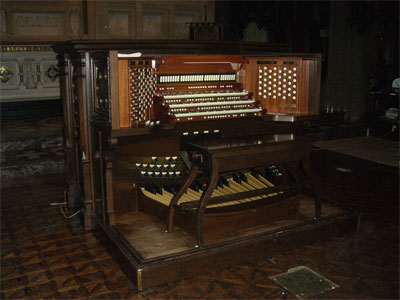
The console of the Trinity Organ.
Photo courtisy of the ATOS.
It is very fitting that the 52nd Annual ATOS Convention of 2007 closed with a performance on a virtual instrument that sounded like the real thing. What follows is the Bone Doctor's personal review of the concert:
I watched the show in its entirity with Windows Media Player 10 plugged into the Microsoft Internet Explorer 7 browser and running full screen with high quality audio and video settings.
That organ sounded very pipelike on the individual pipe samples and extremely real on the non-organ orchestral voices as well. The percussions were downright stunning.
I was truly impressed by Mister Carpenter's ability to wring so much sound out of the three-manual instrument. He played as many as six simultanious parts, and there were times when those six parts created subparts in combination with eachother as his hands and feet danced across the stops, studs, bass clavier and manuals.
Not only were his feet agile and able to heel-and-toe at will to make bombastic four-note chords and speedy glisses on the pedals, his thumbs were always working on the manuals below the ones his other fingers were playing. His thumbs allowed six parts to run concurrently. And he made no mistakes I could detect. Freaking amazing, that!
As I stated earlier, I had the online player set for maximum quality in the audio and high quality in the video. I played it back full screen as a streamed file via an ASX playlist in Media Player running as a plug-in in Internet Explorer. I could not locate the actual file called by the ASX document however, so saving the stream to the local hard drive remains elusive.
The sound, although a tad compressed (as if a mild AGC was in the loop,) was not bad concidering the equipment used. The multiple cameras worked well enough to allow close scruteny of his artistry in action, yet they were also able to zoom out or cut to wider angles which included the surroundings where this historic event took place.
The selection of music was first rate and Mister Carpenter used every control at his command on the giant organ console to deliver a jaw-dropping performance of incredible power, yet delicate taste that won him many standing ovations and three encores after the second set.
The second set was filled with some refreshing arrangements of some great TPO music, done with an orchestral twist, and lightly dusted with abundant classical fire. His Juilliard training really shows through in this tour de farce of what a large well-heeled VTPO in capable hands can do!
To sum up, I was totally awestricken by his lofty talent and precise mastery of this very well crafted machine, and my hat is off to all the fine folks who made this concert and the magnificent organ possible for us to enjoy. You worked together flawlessly and made him look as well as sound great on an organ that knows few, if any, limits. Bravo! Five stars...
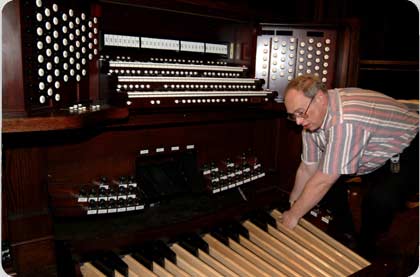
Doug Marshall aligns the foot pedals
to the base of the console during installation.
One of the Marshall & Ogletree partners, Doug Marshall, has this to tell us about the magnificent organ at Trinity Church. We quote him in blue text below:
Greetings.
I am Doug Marshall, the "Marshall" of Marshall & Ogletree. Many of you have wondered how some of the sounds in the Trinity Organ were prepared for Cameron Carpenter's concert and I'm impressed by the number of people on the list who analyzed so many things correctly. I thought I would write to confirm much of what you've already figured out and perhaps add a few details.
When we learned that Cameron Carpenter would be playing M&O's Opus One for the ATOS Convention, we suggested that we might be able to add "a few" theatrical voices for the event. It was a joy to work with Cameron and "a few" became "quite a few" (over 175 stops) by the time we were done.
How do you fit 175 new stops in a console that's already built, without rebuilding it? Fortunately, we have a special stop in each division called an Alternate Stop. This stop can do anything assigned to it, including compound registrations. In the original specification, each of Trinity's five Alternate Stops had eight choices. These were selected to complete each division in specific musical ways.
But, the Alternate can serve other functions as well, such as unification, duplexing, and compound registrations, all without adding to the console real estate. For Cameron's concert, we expanded the Alternates list from 8 to 35 per alternate, for a total of 175 Alternate Stops, some of which were complete choruses in themselves, like "Strings FF 16+8 XIII". Once Cameron realized (way too quickly, I might add!) that he could have any number of ranks on a stop, the email got very busy and the Alternate Stops got busier! Keeping track of which alternate choice is active was kept manageable because each Alternate Stop has its own display.
The organ didn't have a Pedal Divide but it was pretty easy to create compass-limited alternates to "virtually" make one.
We started out with the Tibia combinations as alternate choices, but we ultimately moved the Swell and Choir classical flutes into the alternates and loaded the Tibias onto the Swell and Choir flute knobs.
Lew Williams has correctly explained the percussions. Cameron asked us for a "Percussion Group" with different sounds on groups of keys (an octave of tympani, a half octave of bass drum, gong, snare, etc.). We made this available on all three manuals. And Lew is right that if a snare plays on six keys, it is a little louder on each successive key - a little more work for us, a lot more fun for Cameron! ;-)
The organ's original specification remains intact, courtesy of multiple bootup options, and I happen to know for a fact that Rob Ridgell, the Associate Organist at Trinity has been known to use the theatrical boot-up during church services... Shh! ;-)
If there are other questions, I'll be glad to answer them if I can. In closing, I want to say a big THANK YOU to the ATOS for the honor of including the M&O Organ at Trinity as part of the Convention and especially to Cameron Carpenter for his genius and active interest in working with us to develop something new for us all to enjoy.
Best to you all,
Doug Marshall
Marshall & Ogletree, LLC
Camping In Kern River Valley
My next door neighbor Ernest Todd and I went camping in the Kern River Valley from Sunday through Thursday as the month of June drew to a close. This is what the Walnut Hill Proctions folks do for fun. Stay tuned for pictures from our wonderful trip into the Sierra Nevada Range like the one below of the Black Gulch Bridge...
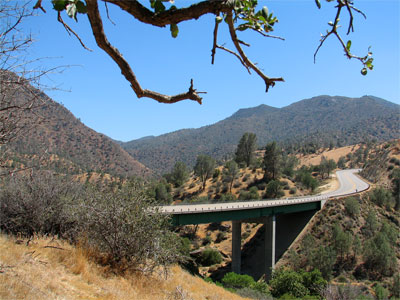
Black Gulch Bridge across Black Gulch Creek
in the south Kern River Valley of California.
This is the Black Gulch Bridge across Black Gulch Creek in southern part of Kern River Valley in Kern County, California. This region lies in a national park about 67 miles southwest of Ridgecrest. It was under this bridge near the bank of the mountain stream that we pitched camp for a week.
This photograph was taken with the camera mounted on a tripod. I took up a position high above the bridge on the summit of an adjoining knoll near a rocky outcropping overlooking the bridge. I took the shot during the late afternoon of our first day there, but the sun was still high in the sky.
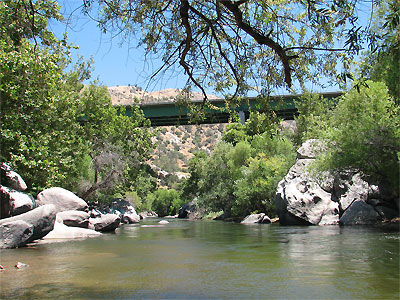
Black Gulch Bridge as seen from the bank of
Black Gulch Creek in Kern River Valley, California.
Here, we are looking up at the Black Gulch Bridge, as seen from our position on the bank of Black Gulch Creek. Every morning when I rose, I could walk down to this little river and take in a spectacular view of this engineering masterpiece framed by the trees, rocks and water below. This is where we went swimming during the heat of the day. Though the air was warm, that water was cold!
Ridgecrest Organ Club Bi-Weekly Meetings
Here in the city of Ridgecrest, California folks love organs of all kinds. Many have electronic organs in their homes. There are enough of these in the area that a club has been formed for the local enthusiasts to get together and enjoy great music and fellowship while gathered around the organ to play.
The Ridgecrest Organ Club meets twice a month on every other Tuesday. The meetings are held at a different member's home each time, by whomever chooses to host the meeting for any particular Tuesday. The first Club Meeting in June was held on the 29th at the residence of Elenoir Winnemore in Ridgecrest.
Recordings of the artists performing at the meeting were made and pictures were taken. Stay tuned as we post this new content in the days ahead.
RELOCATION FUND DRIVE
Although we have settled in at the new location, Walnut Hill Productions is still in somewhat of a bind from a business perspective. Household and personal expenses are taking a hefty slice out of the money Doc gets, as he is disabled and on a fixed and limited income. Replacing his personal property and the musical equipment lost after the relocation, along with aquiring a new residence, will be very expensive.
Most of the company's original equipment was left in Tennessee due to the high cost of shipping. These items must eventually be replaced. Below is a partial listing of the items we need for the studio in order to get back to the recording sessions Doc would like to complete, including albums from the Sub Urban Cowboys and Doc at the Mighty MidiTzer.
|
|
We do not have current pricing or availability of this equipment, but it is conservatively estimated that we will need to raise over 4,000 dollars to eventually aquire everything on the list above. But there is also the need to find a permanent home for Walnut Hill Productions that can not only be a residence for the Bone Doctor but also a place of business for this fledgeling company from the Green Hills of East Tennessee, now relocated to the wonderful city of Ridgecrest in Sunny Southern California.
Our end goal is to construct a portable four manual console for the Walnut Hill 4/36 Mighty WurliTzer Virtual Theatre Pipe Organ, to be powered by jOrgan running a custom organ disposition and soundfont set supplied by Richard "Kent" Allman of Allman Music in Saint Petersburg, Florida. Though an Empire style WurliTzer console would be ideal, the actual VTPO prototype console would be a four manual stack sitting on a foldable pedestal.
The music rack would be a touch sensative LCD monitor for stop control, manuscript, etc.. The manuals would each have ten settable pistons and ten factory preset pistons. The Pedal would have suitable bass. The pedestal would also have the five shoes, four piano pedals and several toe studs mounted on the crossmember above the bass pedals.
Doc and Tom Hoehn have created a Pay Pal account for easily and securely receiving contributions from all who want to see this relocation take place, which will allow Walnut Hill to make major strides forward for the King of Instruments.
Below is a listing of those who have genorously contributed funds and items to date:
|
|
|
|
|
|
|
These most kind and generous folks have earned memberships in the Walnut Hill Organ Club and will be notified of their membership status when the club goes official. We have decided to push forward with the organization while awaiting an ATOS charter. Club members will receive printed certificates and membership cards, plus access to the WHOC online community via direct email notifications. This is just a small token of appreciation for all who are making the Walnut Hill website possible and freely available for the world to enjoy.
There are other pledges pending. Anyone can contribute as much or as little as they see fit by clicking the "Make a Donation" button above. You can also send checks via standard mail to the following address, should you choose to not use the Pay Pal account. Please make checks payable to Richard Mogridge, with the words "Relocation Fund" in the memo line. The address is:
|
Richard Mogridge |
If you have questions about the relocation fund, you can call the Bone Doctor at the Walnut Hill Office of Operations to learn more.
That telephone number is 1-727-230-2610.
All contributors will get recognized at the site should they choose, or they can remain anonymous, simply by letting the Bone Doctor know their preferences via email.
This is a major move forward for Walnut Hill Productions, one of the fastest growing TPO sites on the internet. Become a part of history by making your donation today. Please help us to continue the work we are doing as we continue to grow, adding new features and more services such as broadcasting audio and video for all to enjoy. You'll be glad you did.
We are thanking you in advance for your generosity and support in this grand endevour.
God bless, and happy playing.
The Bone Doctor
Member ATOS/President WHOC
House Organist and Webmaster
Walnut Hill Productions
"It's all about the King of Instruments!"
Hit Count Since 04/02/2004
The figures below represent the approximate daily hit count for the site since going online on April 2nd of 2004. Counter checks begin around ten in the morning and end around ten in the evening. Currently, that total stands at over 54,290 happy campers in the Land of the King!
|
|
|
ADVERTISEMENTS |
|
|
|
Mighty MidiTzer Style 216
|
|
Download MidiTzer Version 0.84 Did you ever imagine you could put a Theatre Pipe Organ inside your computer? Well, now you can, with the Mighty MidiTzer by Jim Henry and Crew Glazjev. Best of all, it is absolutely free! Just click the picture to the left to get started on your way to playing the Style 216 2/10 Mighty WurliTzer Theatre Pipe Organ virtually every day! Listen to the Mighty MidiTzer! Below are some cuts from various Featured Artists here at Walnut Hill that will give you an idea of what the Mighty MidiTzer sounds like.
|
|
Pinellas Park Mighty WurliTzer |
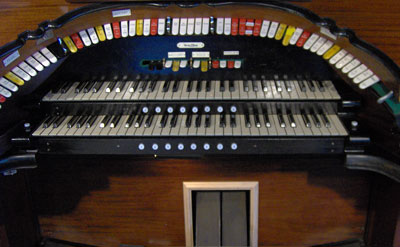 The stop sweep of the 2/9 Mighty WurliTzer Theatre Pipe Organ installed at the Pinellas Park Auditorium in Pinellas Park, Florida. |
|

